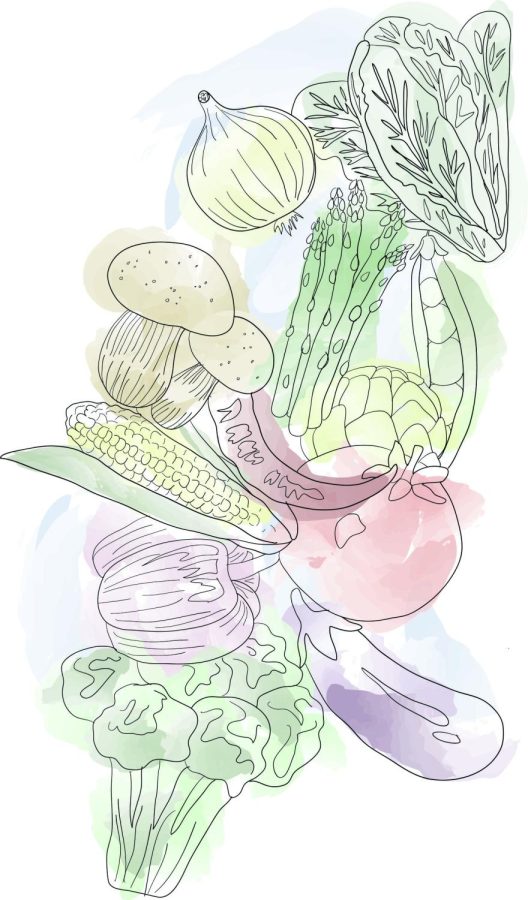Bringhurst: The Hungry Student Is More than a Stereotype
(Graphic by Storey McDonald | The Daily Utah Chronicle)
October 29, 2021
Since the first day of the semester, the University of Utah’s Feed U Pantry has welcomed almost two hundred hungry new clients. On a larger scale, millions of people around the world suffer from food insecurity and malnutrition because they cannot afford a healthy diet.
To top it all off, agriculture is the leading source of pollution in many countries, while nearly 40% of all food in America is wasted. College students regularly find themselves unable to pay for food, making a sustainable diet even harder to access. Improving sustainable agriculture is essential to eliminating hunger and reducing environmental impacts.
The Student Hunger Crisis
Hunger is a persistent problem, particularly for low-income households. College students are no exception — 39% of students surveyed by Temple University in 2019 had experienced food insecurity in the last 30 days. Many students place food as a lower priority to make ends meet.
“A lot of them have to choose between getting groceries or paying rent or tuition,” said Jackie Smith, director of the Feed U Pantry. Food insecurity impacts students in several aspects. “High-stress levels, higher dropout rates, mental and physical health issues, lack of focus in class, poor sleep quality, just to name a few,” said Smith.
The University of Utah implemented measures such as the Feed U Pantry, which provides packaged food and fresh produce from the Edible Campus Gardens, to tackle student hunger. “People come to the pantry specifically for the produce,” said Smith. “Our produce flies off the shelves when they deliver.” The pantry relies heavily on donations and is always open to extra assistance. For those afraid of the stigma associated with walking into the pantry and asking for help, the Feed U Pantry also offers to-go bags at the front desk of the Student Union.
The Student Food Security Act of 2021 was recently introduced to the U.S. Senate, which would expand eligibility for government food assistance if passed. This would feed students, but government and school assistance are only temporary solutions to the problem, especially when the available assistance isn’t always healthy. We need to invest in sustainable agriculture to make nutritional food more accessible and affordable.
Sustainable Agriculture Provides a Solution
An analysis by the Journal of Public Health Nutrition concluded that a food secure world cannot be obtained without sustainable agricultural development. Additionally, the Food and Agriculture Organization of the United Nations found that the Sustainable Development Goal of ending hunger by 2030 will be missed by a margin of nearly 660 million people if we do not radically adapt agricultural production to new climate conditions.
Agricultural practices like biotechnology, chemical fertilizers and pesticides have increased in usage, but they are not working to decrease malnutrition or environmental impacts. Experts at the Environmental Working Group recommend implementing conservation practices like crop diversification, sprinkler irrigation and zero-soil tillage to adapt to climate change. They reported that adopting zero-soil tillage alone could lift almost 9% of people out of hunger by 2050.
College students are taking on these initiatives. Davidson College in North Carolina boasts a student-operated farm spanning three acres with an irrigation system that doesn’t use synthetic fertilizers or pesticides. The farm remains financially self-sufficient by selling its harvest to the school’s dining services, providing fresh food for students.
Food security isn’t simply having access to food. Many affordable food options come at the expense of both nutritional and environmental damage.
To combat hunger, we need to present healthier food options at an affordable price. We can support local agriculture to help implement this on an individual level. Expanding and contributing to the Edible Campus Gardens is a good step toward further sustainability.
Salt Lake City offers several farmers’ markets and community gardens, but many low-income households still struggle to afford fresh local produce. A California farmers market reported that sales made with food stamps in 2019 dropped to nearly half of those from 2016. Many college students are not eligible for food stamps, making public fresh produce even harder to obtain.
Think Before You Eat
Individuals have more power to reduce greenhouse gas emissions than we may think. The more people adopt plant-based diets, the less demand there is for large-scale food production. Your diet also has an individual environmental footprint, which you can make the decision to minimize.
Maggie Gill, a biology professor at the University of Aberdeen, offered three key principles. First, aim to minimize waste. Don’t purchase more than you can eat and plan healthy portion sizes. Second, eat seasonally. Purchasing out-of-season produce increases the demand for processed foods. Lastly, minimize consumption of red meat and dairy products, as these foods are associated with negative environmental impacts.
“We have become so accustomed to going to the grocery store and buying anything at any time,” said Jessica Kemper, University of Utah’s Sustainable Food Initiatives Manager. “I think the shift to move towards eating seasonally and more sustainably could be challenging because of the overproduction of food.” Though it is important for students to choose to live sustainably, it can’t be implemented widely until healthy food is affordable and accessible to college students. And that likely won’t be until sustainable food production is implemented on a larger scale.
Many experts preach the necessity of adopting sustainable diets, but eating low-carbon cost foods relies on radical changes to the way our world produces food. It is crucial for our society to adopt a more environmentally friendly approach to agriculture to solve both hunger and the climate crisis.









